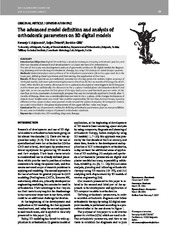Приказ основних података о документу
The advanced model definition and analysis of orthodontic parameters on 3D digital models
Novi model za definisanje i analizu ortodontskih parametara na 3D digitalnim modelima
| dc.creator | Majstorović, Nemanja | |
| dc.creator | Živković, Srđan | |
| dc.creator | Glišić, Branislav | |
| dc.date.accessioned | 2020-07-02T13:14:18Z | |
| dc.date.available | 2020-07-02T13:14:18Z | |
| dc.date.issued | 2017 | |
| dc.identifier.issn | 0370-8179 | |
| dc.identifier.uri | https://smile.stomf.bg.ac.rs/handle/123456789/2267 | |
| dc.description.abstract | Introduction/Objective Digital 3D modeling is slowly becoming an everyday orthodontic practice, and after two decades of research and development it is a basic element of e-orthodontics. The aim of this study was development and use of geometric entities on 3D digital models for diagnosing, planning and monitoring of orthodontic therapy, by using CAD (computer aided design) systems. Methods Statistical analysis and synthesis of 54 orthodontic parameters (28 in the upper and 26 in the lower jaw), defining three hypotheses and their testing, the application of the t-test. Results All three hypotheses are confirmed, convenience of using geometric entities, higher accuracy of 3D digital models, and more substantial displacement of teeth in the first six months of therapy (Student's t-test). After the first six months, distances in the x-y plane (occlusal plane) were bigger in both the upper and the lower jaw; additionally, the distances in the y-z plane (medial plane) decreased on the left and right side, so we can say that the first phase of therapy had success and that both jaws are wider. At the next four controls, parameters showed slight progress that was not statistically significant. Overall, after 11 months of therapy, there was a considerable improvement in the x-y plane, while changes in distances of clinical crown heights were very small. This could be explained by the fact that, during therapy, by using different arches, upper molars were pushed inside, toward the palate. Analyzing 3D computer models, we could notice that in this plane displacement of the upper left first molar was larger. Conclusion The use of geometric entities for defining orthodontic parameters gives us new possibilities for accurate and reliable analysis of patient's orthodontic condition. | en |
| dc.description.abstract | Uvod/Cilj 3D modeliranje postaje sve više svakodnevna ortodontska praksa, koja posle dve decenije istraživanja i razvoja biva bazni element e-ortodoncije. Cilj rada je bio da se izvrši razvoj i pokaže primena geometrijskih entiteta (GE) na 3D modelima za dijagnozu, planiranje i praćenje ortodontske terapije primenom opštih kompjuterski dizajniranih sistema. Metode Statistička analiza i sinteza 54 ortodontska parametra (28 za gornju vilicu i 26 za donju vilicu), definisanje tri hipoteze i njihovo testiranje, primena t-testa. Rezultati Potvrđene su sve tri hipoteze: pogodnost za primenu GE, veća tačnost 3D modela i veće pomeranje zuba u prvih šest meseci terapije (t-test). Posle prvih šest meseci uočeno je da su vrednosti rastojanja u x-y ravni (okluzalna ravan) u gornjoj i donjoj vilici veće, a da je pored toga došlo do smanjenja rastojanja u y-z ravni (medijalna ravan) i sa leve i sa desne strane, što znači da je prva faza terapije uspešno okončana i da je došlo do proširenja obe vilice u širini. U naredne četiri kontrole parametri su uglavnom pokazivali blagi rast, koji nije bio statistički toliko značajan. Sveukupno kad se sagleda, nakon jedanaest meseci terapije vidljiv je napredak u x-y ravni, dok su najmanja pomeranja viđena kod kliničkih visina krunica zuba. Ovo se objašnjava činjenicom da su tokom terapije, primenom određenih lukova, gornji molari uvučeni unutra, tj. pomereni prema nepcu. Analizom 3D digitalnih modela moguće je uočiti da je nastalo veće pomeranje kod gornjeg levog molara u ovoj ravni. Zaključak Primena GE za definisanje ortodontskih parametara daje nove mogućnosti za tačnu i pouzdanu analizu ortodontskog stanja pacijenta. | sr |
| dc.publisher | Srpsko lekarsko društvo, Beograd | |
| dc.rights | openAccess | |
| dc.rights.uri | https://creativecommons.org/licenses/by-nc/4.0/ | |
| dc.source | Srpski arhiv za celokupno lekarstvo | |
| dc.subject | orthodontics | en |
| dc.subject | 3D modeling | en |
| dc.subject | diagnosis | en |
| dc.subject | therapy | en |
| dc.subject | ortodoncija | sr |
| dc.subject | 3D modeliranje | sr |
| dc.subject | dijagnoza | sr |
| dc.subject | terapija | sr |
| dc.title | The advanced model definition and analysis of orthodontic parameters on 3D digital models | en |
| dc.title | Novi model za definisanje i analizu ortodontskih parametara na 3D digitalnim modelima | sr |
| dc.type | article | |
| dc.rights.license | BY-NC | |
| dcterms.abstract | Мајсторовић, Немања; Глишић, Бранислав; Живковић, Срђан; Нови модел за дефинисање и анализу ортодонтских параметара на 3Д дигиталним моделима; Нови модел за дефинисање и анализу ортодонтских параметара на 3Д дигиталним моделима; | |
| dc.citation.volume | 145 | |
| dc.citation.issue | 1-2 | |
| dc.citation.spage | 49 | |
| dc.citation.epage | 57 | |
| dc.citation.other | 145(1-2): 49-57 | |
| dc.citation.rank | M23 | |
| dc.identifier.wos | 000397062800009 | |
| dc.identifier.doi | 10.2298/SARH151207011M | |
| dc.identifier.scopus | 2-s2.0-85016116801 | |
| dc.identifier.fulltext | https://smile.stomf.bg.ac.rs/bitstream/id/837/2262.pdf | |
| dc.type.version | publishedVersion |


